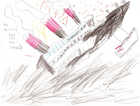 Titanic.com - Titanic News, Photos, Articles & Research | Forum Index Titanic.com - Titanic News, Photos, Articles & Research | Forum Index Titanic historic Titanic historic  An alternate iceberg damage theory An alternate iceberg damage theory
|
Browsing this Thread:
78 Anonymous Users
 Bottom Bottom  Previous Topic Previous Topic  Next Topic Next Topic |
| |
|
|---|
| Poster | Thread | Rated: 2 Votes 2 Votes |
|---|
|
An alternate iceberg damage theory | #1 |
|
|---|---|---|---|

Joined: 2004/12/28
From Molly Brown's home town
Posts: -1
Group:
No forum  |
Here is the best photo of the suspected iceberg that
is believed to have sunk the Titanic. It is the only surviving photo of that berg. It was made into a post card. http://img.photobucket.com/albums/v607/sundancekid17/Iceberg/titaniciceberg.jpg A friend of mine on another discussion group and I had been dicussing the possibly of running aground the iceberg by the Titanic and that the damage would have been to the very bottom of the Titanic. I am more and more interested in the possibility that there are several factors that if this scenario is correct that these factors can be devastating in the behavior of the steel plates. First one needs to go back and read the testimonies of those survivors who testified that the iceberg extended above the railing and that when the titanic side swiped the iceberg that the ship was close enough to the wall of the ice berg that the ice debris actually fell on board the Titanic. Now iceberg configuration is very important to understand. The typical iceberg floats with a average of only 10% of the ice above water level and the remaining 90% is submerged. This is a basic formula but to be more exact explanation of the "tip of the iceberg" expression can be explained as follows: Icebergs float because the density of ice (around 900 kg per cubic meter) is lower than that of seawater (around 1025 kg per cubic meter). The ratio of these densities tells us that 7/8 of the iceberg's mass must be below water. Usually icebergs are 20% to 30% longer under the water than above and not quite as deep as they are long at the waterline. If you look at a surface level view of a iceberg you will see that the submerged portion will extend in all direction past the surface ice's walls. See the following iceberg: http://img.photobucket.com/albums/v607/sundancekid17/Iceberg/iceberg.jpg Now for the Titanic to be close enough to brush the surface walls and allow ice debries to fall onto the deck than it is safe to assume that she had to past over the larger submerged counter weighted larger mass of ice. Now if the Titanic did ride up on this submerged ice than a new factor is introduced! Before we were figuring the ship's speed of 22 1/2 knots striking at a slight angle a floating iceberg. If that were the case that the blunt trama force would be decreased where as the iceberg would actually be pushed sideways to a small degree and the Titanic would herself have experienced a kinetic strike and would have caused the bow of the ship to slightly bounce way from the wall just before being forced back toward the stern when the stern get kicked out away from the iceberg. Factoring in the weight of the loaded payload area and all the supplies, crews and passengers plus the actual ship and now enter the senerio that the Titanic did ride up on the ice. First thing you now introduce a new factor that being the weight of the Titanic bearing down on the irregular submerged ice surface as it slides over the submerged ice shelf. (Not floats over but skids across the ice with the weight of the Titanic exerting a heavy downward force.) This would definitely have increased the amount of force excerted to the bottom steel plates. The weight of the Titanic bearing down on the bottom plates in contact with the ice would be many times greater that those plates on the side that side swiped the side of the iceberg. Here are some more aerial photos of icebergs where you can see the submerged ice that extends out past the surface walls. http://img.photobucket.com/albums/v607/sundancekid17/Iceberg/blockiceberg2.jpg http://img.photobucket.com/albums/v607/sundancekid17/Iceberg/101Iceberg.jpg http://img.photobucket.com/albums/v607/sundancekid17/Iceberg/051Iceberg.jpg Now to be close enough for the wall of most common icebergs to extend over the railing yet be close enough to fall onto the deck you can assume that the Titanic would have had to rode up on the submurged portion of the iceberg. If you go back and look at the actual Titanic iceberg and view the suspected damage the Titanic had believed to have caused on the iceburg you can see that the side of the Titanic would have actually been up against the above surface portion of the iceberg. I would be interested in your opinions! Sundance |
||
Posted on: 2005/1/15 20:46
  |
|||
| Subject | Poster | Date |
|---|---|---|
| |
Martyn | 2005/1/15 21:27 |
| |
clinton | 2005/1/18 10:42 |
| |
sundance | 2005/1/18 18:40 |
 Top Top  Previous Topic Previous Topic  Next Topic Next Topic |
|
























 Topic options
Topic options Flat
Flat Newest First
Newest First sundance
sundance


 You cannot start a new topic.
You cannot start a new topic. You can view topic.
You can view topic.
